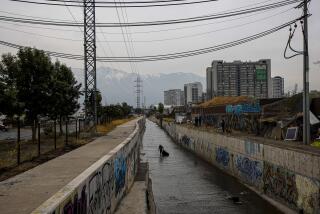Chile quake leaves Concepcion’s dreams up in the air
- Share via
Reporting from Concepcion, Chile — Belen Portino was looking forward to finishing high school and continuing her studies in a top university before last month’s earthquake struck, shutting down Chile’s second city.
“All of a sudden there’s no school, no teachers, we don’t know what’s going to happen,” the animated 16-year-old said as she and an elder sister made the cheerless rounds of looter-ravaged shops downtown looking for food for their family. “Concepcion was a city where I had a future. It’s a great place to live. Now everything’s up in the air.”
The massive damage wrought by the magnitude 8.8 earthquake and ensuing tsunami, which killed hundreds nationwide, has been a demoralizing strike for this bustling urban area of about 1 million people. Beyond the death and vast destruction, the disaster put individual aspirations and dreams in doubt.
Despite persistent social inequities, Chile stands as a modern, prosperous nation proud of its status as a model of economic and political stability in Latin America. The lack of social mobility that plagues the region is also evident in Chile, but there are ample opportunities for self-advancement.
Concepcion, about 300 miles south of the capital, Santiago, is a major manufacturing, petro-chemical and trade hub that has prospered and grown despite a history replete with killer earthquakes and tsunamis. The city anchors the economy in Chile’s Bio Bio region, a major center of forestry, fishing and agriculture. Like other Chilean port zones, Concepcion has benefited from escalating trade with China.
The city also ranks as an intellectual center, home to half a dozen major universities, and boasts a vibrant arts scene. It was an incubator of seminal Chilean rock groups such as Los Tres and Los Bunkers, both part of the broader cultural revival that followed the return to democracy two decades ago after a stultifying and often-brutal military dictatorship led by the late Gen. Augusto Pinochet.
During the 1960s and early ‘70s, Concepcion was a hotbed of Cold War leftist activism. But the allure of revolution has waned as a series of post-dictatorship, center-leftist governments have sought to create a modern social democracy.
Lawlessness
Recently, penquistas, as residents here are known, almost universally applauded as the government belatedly dispatched troops in response to an explosion of post-quake looting and rioting that appalled a nation with a tradition of law and order.
Analysts here spoke of two shocks: the physical jolt of the earthquake and tsunami, followed by the social convulsion of pillaging and lawlessness. Middle-class residents set up barriers on the streets and wielded home-fashioned clubs in an astonishing display of vigilante self-defense.
“What we see now is an almost universal sense of abrupt uncertainty,” said Marcela Rodriguez, a psychiatrist who was providing aid to psychologically battered residents. “People [who] come to us are suffering from a kind of post-traumatic stress.”
Francesca Maritano, 22, a student at San Sebastian University, volunteered at an aid center in part to take her focus off her own stress.
“It creates a lot of anxiety; everyone wonders what will happen,” said Maritano. “With so much going on, I felt useless being at home doing nothing. At least now I’m helping people.”
A series of Twitter messages captured the sense of alarm among penquistas outraged about roving gangs of looters who targeted homes and shops alike.
“We urgently need the army in the streets of greater Concepcion,” read one entry of many in a similar vein. “The looting and assaults are becoming uncontrollable.”
Many Concepcion residents interviewed after the earthquake spoke with optimism, often citing the city’s traditional upbeat character.
“The job of art and music now is to help lift the spirit of Concepcion,” said Gerson Guzman, a rock guitarist and online news editor.
The barriers to some semblance of normality were many. Immediately after the quake, many residents were faced with limited running water, electricity and phone service. Long lines persisted at gasoline stations and the few shops that opened. People wandered about for hours seeking food, diapers and other necessities. Thousands were in shelters or with relatives.
The earthquake buckled roads and left hundreds of buildings in ruins. News photos of a toppled 15-story apartment building near downtown where many died became a signature image of the city. At least two other modern towers face demolition because of quake damage.
At the adjacent port of Talcahuano, an important component of Concepcion’s economic engine, the scenario remained even bleaker.
Concepcion was spared the force of the tsunami, but the port was not. The combination of the earthquake and monster waves left Talcahuano a wreck. Giant cargo containers were shoved into buildings and 75-foot steel-hulled fishing boats were thrown onto shore as though tossed aside by a malevolent giant.
As incredulous gawkers strolled through the chaos one day recently, an immense elephant seal lay in the sunshine and lazily scratched atop an upturned boat just offshore, exuding an insouciance that seemed to mock humanity’s concern for its fallen monuments.
Scavenging
On the coastal plain to the north, miles of beachfront were strewn with a pungent mix of dead fish and crabs and a hodgepodge of tsunami-dispersed maritime detritus: wrecked boats, outboard engines, sacks of fish meal, furniture and other scattered objects.
Hundreds of people scavenged through the debris, breaking into containers unmoored from ships as they looked for stores of cooking oil, wood, food and other potentially useful items. They were purposeful in their searches, seeking some limited hedge against the prospect of protracted hard times.
“This is what we’re left with,” said one scavenger, Miguel Arrigada, 43, a minibus driver from Concepcion who anticipates being out of work for a long time. “They say that nature must strike back every few years. Now we’ve seen it.”
patrick.mcdonnell @latimes.com
More to Read
Sign up for Essential California
The most important California stories and recommendations in your inbox every morning.
You may occasionally receive promotional content from the Los Angeles Times.












